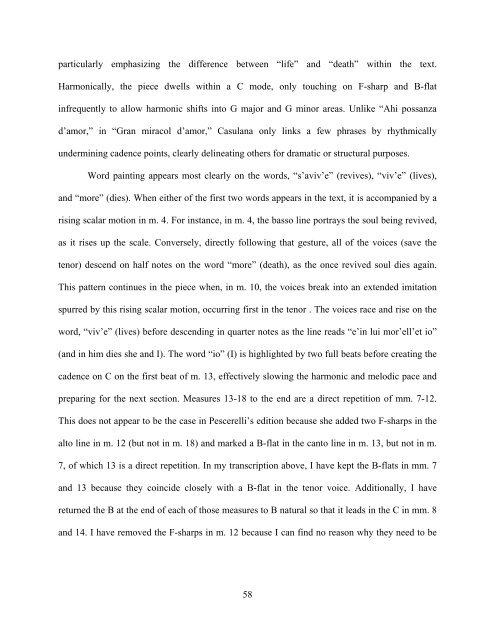Download - D-Scholarship@Pitt - University of Pittsburgh
Download - D-Scholarship@Pitt - University of Pittsburgh
Download - D-Scholarship@Pitt - University of Pittsburgh
You also want an ePaper? Increase the reach of your titles
YUMPU automatically turns print PDFs into web optimized ePapers that Google loves.
particularly emphasizing the difference between “life” and “death” within the text.<br />
Harmonically, the piece dwells within a C mode, only touching on F-sharp and B-flat<br />
infrequently to allow harmonic shifts into G major and G minor areas. Unlike “Ahi possanza<br />
d’amor,” in “Gran miracol d’amor,” Casulana only links a few phrases by rhythmically<br />
undermining cadence points, clearly delineating others for dramatic or structural purposes.<br />
Word painting appears most clearly on the words, “s’aviv’e” (revives), “viv’e” (lives),<br />
and “more” (dies). When either <strong>of</strong> the first two words appears in the text, it is accompanied by a<br />
rising scalar motion in m. 4. For instance, in m. 4, the basso line portrays the soul being revived,<br />
as it rises up the scale. Conversely, directly following that gesture, all <strong>of</strong> the voices (save the<br />
tenor) descend on half notes on the word “more” (death), as the once revived soul dies again.<br />
This pattern continues in the piece when, in m. 10, the voices break into an extended imitation<br />
spurred by this rising scalar motion, occurring first in the tenor . The voices race and rise on the<br />
word, “viv’e” (lives) before descending in quarter notes as the line reads “e’in lui mor’ell’et io”<br />
(and in him dies she and I). The word “io” (I) is highlighted by two full beats before creating the<br />
cadence on C on the first beat <strong>of</strong> m. 13, effectively slowing the harmonic and melodic pace and<br />
preparing for the next section. Measures 13-18 to the end are a direct repetition <strong>of</strong> mm. 7-12.<br />
This does not appear to be the case in Pescerelli’s edition because she added two F-sharps in the<br />
alto line in m. 12 (but not in m. 18) and marked a B-flat in the canto line in m. 13, but not in m.<br />
7, <strong>of</strong> which 13 is a direct repetition. In my transcription above, I have kept the B-flats in mm. 7<br />
and 13 because they coincide closely with a B-flat in the tenor voice. Additionally, I have<br />
returned the B at the end <strong>of</strong> each <strong>of</strong> those measures to B natural so that it leads in the C in mm. 8<br />
and 14. I have removed the F-sharps in m. 12 because I can find no reason why they need to be<br />
58















